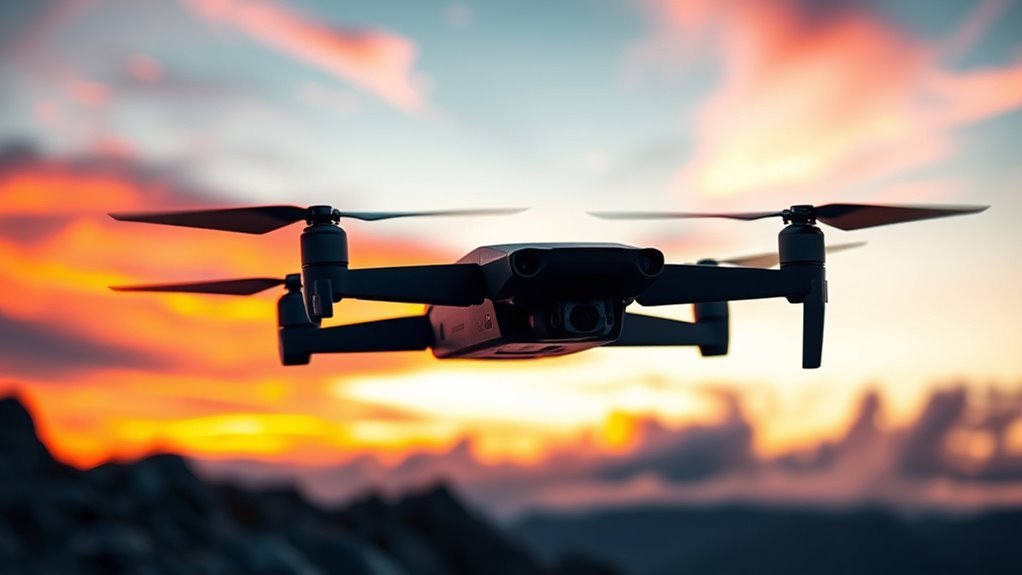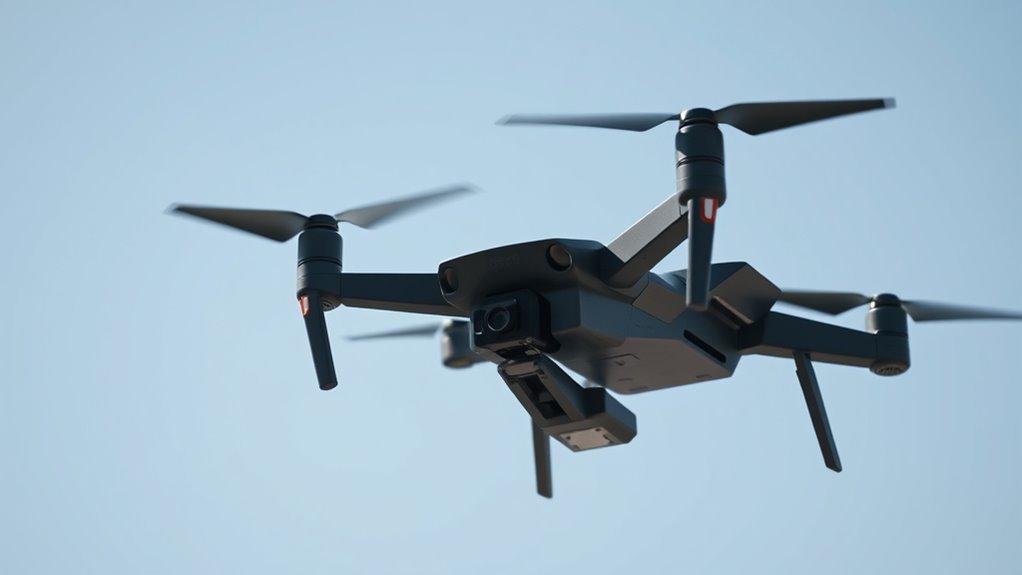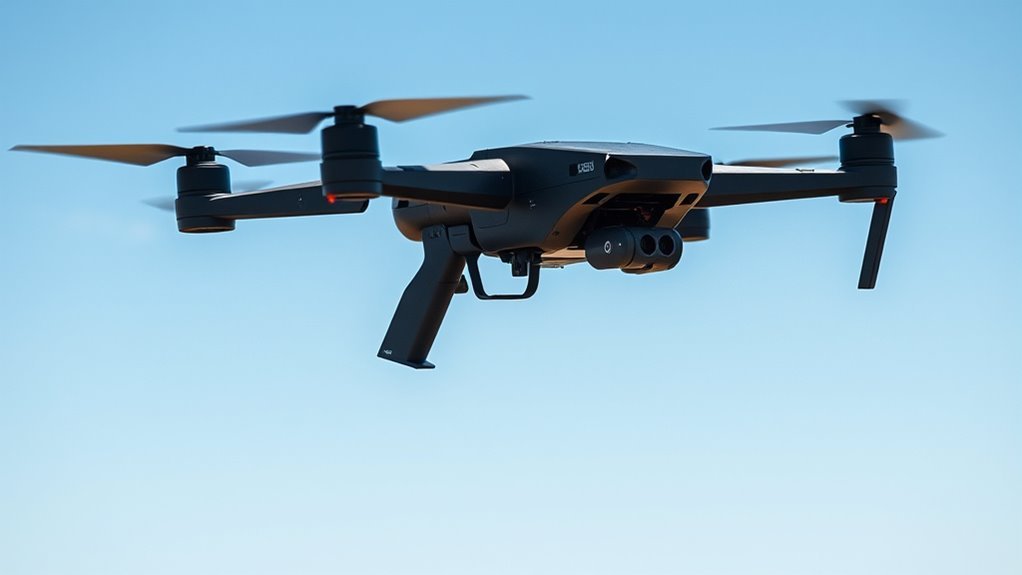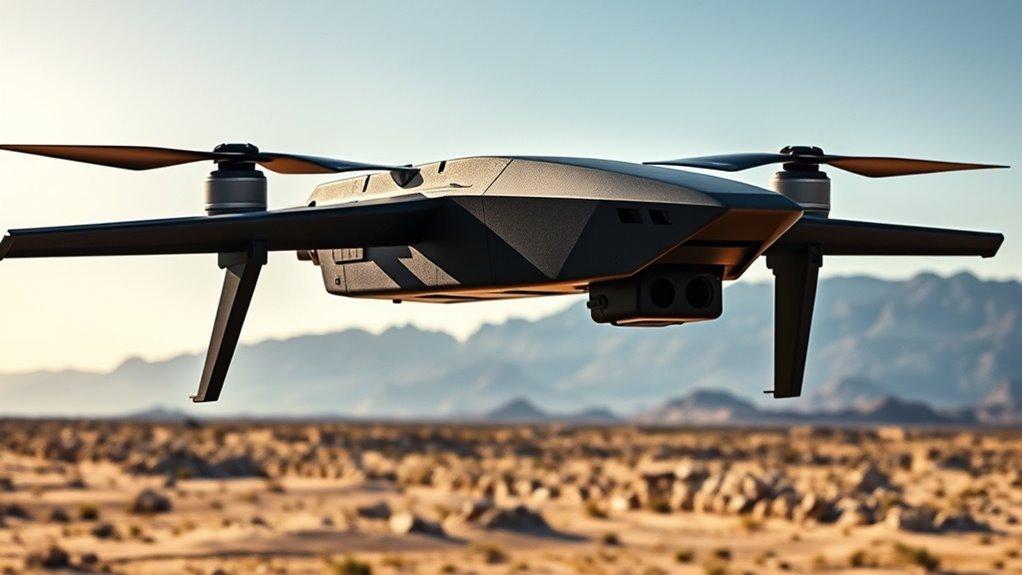The Uzi Drone is a military-grade unmanned aerial vehicle (UAV) designed for tactical surveillance and combat support. It features advanced stabilization systems, real-time data transmission, and a modular design for versatile payloads. With a range of up to 50 kilometers and a flight duration of about five hours, it excels in reconnaissance and precision strikes. Its capabilities are further enhanced by a compact design, making it highly portable for various missions. Learn more about its specifications and tactical applications.
Overview of the Uzi Drone

The Uzi drone, named after the iconic submachine gun, represents a blend of advanced technology and tactical design. It leverages cutting-edge drone technology to enhance situational awareness and operational effectiveness. Engineered for military applications, the Uzi drone features a compact structure, allowing for maneuverability in diverse environments. Its real-time data transmission capabilities enable precise surveillance and reconnaissance missions, proving essential on the battlefield. You’ll appreciate its autonomous flight features, which reduce the risk to personnel while increasing mission efficiency. Furthermore, the integration of AI enhances target identification, ensuring that strategic objectives are met without compromising freedom. By understanding the Uzi drone, you grasp the potential of modern warfare and the crucial role drone technology plays in safeguarding liberty.
Historical Context and Development

To understand the Uzi drone’s significance, you must consider its origins and design principles. Initially developed for specific military applications, the Uzi drone reflects the evolution of technology in unmanned systems. Analyzing its advancements reveals how design choices have adapted to meet emerging operational demands.
Origin and Design
Although often associated with its compact and lethal design, the Uzi’s origins trace back to the post-World War II era in Israel, where the need for a reliable submachine gun emerged amid rising tensions in the region. Developed by Uziel Gal in 1950, the Uzi design was revolutionary for its time. Its simplicity allowed for rapid production, making it ideal for a newly formed military. The Uzi’s blowback operation and open-bolt mechanism contributed to its reliability in various conditions, while its lightweight frame guaranteed ease of use. This unique combination of factors has cemented the Uzi’s place in military history, symbolizing both innovation and the pursuit of freedom in a turbulent era. Understanding Uzi history enhances appreciation for its enduring impact.
Evolution of Technology
As the Uzi evolved, advancements in technology greatly influenced its capabilities and applications. Initially designed for close combat, the integration of drone technology expanded its utility. You’ll notice that drone advancements have allowed for enhanced surveillance and targeting accuracy, transforming tactical operations. The technological impacts on the Uzi’s design also include lightweight materials and modular components, which improve maneuverability and adaptability in various scenarios. This shift towards incorporating drones has not only increased operational efficiency but has also provided greater freedom in mission execution. By embracing these innovations, the Uzi has remained relevant, reflecting the changing landscape of warfare. Understanding this evolution helps you appreciate how technology continues to redefine combat strategies and the tools employed by modern forces.
Design and Specifications

When evaluating the Uzi drone, you’ll notice its robust body structure and the materials employed, which contribute to its durability and performance. Its flight capabilities are enhanced by advanced features that optimize maneuverability and stability. Understanding these design elements is essential for evaluating its overall operational effectiveness. Additionally, its aerodynamic design plays a crucial role in enhancing stability and reducing air resistance during flight.
Body Structure and Materials
The body structure of the Uzi drone is engineered for both durability and lightweight performance, guaranteeing it can withstand various operational conditions. You’ll notice that the body design incorporates advanced drone materials, primarily carbon fiber and reinforced polymer composites. These materials not only reduce weight but also enhance resilience against impacts and environmental stressors. The aerodynamic contours minimize drag, contributing to improved flight efficiency. You’ll appreciate how the design prioritizes modularity, allowing for easy repairs or upgrades. Additionally, the strategic placement of components within the body assures peak weight distribution, enhancing stability during flight. Overall, the Uzi drone’s body structure reflects a meticulous balance between strength and agility, making it a formidable choice for diverse applications.
Flight Capabilities and Features
With advanced engineering at its core, the Uzi drone boasts exceptional flight capabilities and features that cater to a variety of operational needs. Its flight performance is optimized for both speed and endurance, allowing you to cover extensive areas with minimal downtime. The drone’s cutting-edge propulsion system guarantees swift ascents and descents, while its advanced sensors facilitate stable hover and precision navigation. During maneuverability testing, the Uzi demonstrated remarkable agility, making it adept in dynamic environments. You can easily execute complex flight paths, enhancing its versatility for surveillance or reconnaissance missions. Additionally, its robust design and lightweight materials contribute to enhanced stability, assuring you achieve your objectives with confidence, no matter the conditions.
Key Features of the Uzi Drone
Equipped for versatility and performance, the Uzi drone boasts several key features that enhance its operational capabilities. This drone technology is tailored for military applications, ensuring reliability and adaptability in various scenarios.
| Feature | Description |
|---|---|
| Payload Capacity | Supports various sensor types |
| Range | Up to 50 kilometers |
| Flight Duration | Approximately 5 hours |
With a robust design, the Uzi drone incorporates advanced stabilization systems and real-time data transmission, allowing you to maintain situational awareness. Also, its modular construction enables quick configuration changes, ensuring you’re prepared for different missions. The Uzi drone stands as a demonstration of cutting-edge innovations, providing the freedom needed for tactical operations.
Tactical Applications and Uses
As tactical environments become increasingly complex, the Uzi drone proves invaluable for various military operations. You can leverage its capabilities for tactical surveillance, providing real-time intelligence and situational awareness. Its advanced sensors allow you to monitor enemy movements and identify threats without exposing personnel to danger. Additionally, the Uzi drone excels in combat support roles, offering precision strike capabilities while minimizing collateral damage. This versatility enables you to adapt to diverse scenarios, whether it’s reconnaissance in hostile territories or coordinating airstrikes with ground forces. By integrating the Uzi into your operations, you enhance mission effectiveness and maintain the upper hand in asymmetrical warfare. Its reliability and efficiency make it a critical asset in modern military engagements. Moreover, its modular payloads allow for enhanced adaptability in various tactical missions. The Uzi drone’s redundant systems ensure operational integrity even in challenging conditions.
Comparison With Other Drones
The Uzi drone stands out in a crowded field of unmanned aerial systems, particularly when compared to its counterparts. Its capabilities, such as advanced stabilization, enhanced payload options, and superior battery life, allow for extended operational range and versatility. In Uzi comparisons with drones like the DJI Matrice and the Parrot Anafi, you’ll notice a marked difference in ruggedness and adaptability in challenging environments. While others may excel in specific niches, the Uzi offers a balanced approach, integrating high-tech sensors and real-time data processing. This makes it ideal for tactical applications where precision and reliability are paramount. Additionally, its advanced sensors enhance situational awareness, further solidifying its position in the tactical drone market. The Uzi drone’s thermal imaging capabilities also improve overall operational efficiency, making it an invaluable tool in emergency response scenarios. Ultimately, if you’re seeking a drone that combines cutting-edge technology with operational freedom, the Uzi is a formidable choice in today’s drone landscape.
Advantages and Limitations
When evaluating the Uzi drone, you’ll find several advantages that enhance its operational effectiveness, such as its compact design and advanced maneuverability. However, it’s crucial to reflect on the limitations that may impact its performance, including battery life and payload capacity. Understanding these factors will help you make informed decisions regarding its application in various scenarios.
Advantages of the Uzi Drone
While many drones have specific strengths, the Uzi Drone stands out due to its unique combination of portability, versatility, and advanced technology. You’ll appreciate its cost efficiency, enabling you to maximize performance without breaking the bank. The Uzi’s lightweight design makes it easy to transport, allowing for quick deployment in various environments. Its operational flexibility means you can adapt it for multiple tasks, whether it’s surveillance, reconnaissance, or aerial photography. With impressive battery life and rapid recharge capabilities, you can stay in the field longer, gathering essential data. Additionally, the Uzi Drone’s user-friendly interface and intuitive controls enhance your experience, making it accessible for both beginners and seasoned operators. This drone empowers you to achieve high-quality results with minimal hassle.
Limitations of the Uzi Drone
Despite its many advantages, the Uzi Drone does have some limitations that users should consider. One primary concern is the operational constraints imposed by battery life, which can limit flight duration and range. Users may find performance issues arise in adverse weather conditions, affecting stability and control. The drone’s payload capacity can restrict its ability to carry additional equipment, which may be necessary for specific missions. Additionally, while its design is compact, this can also lead to challenges in maneuverability in tight spaces. Overall, understanding these limitations is essential for effective planning and mission execution, ensuring that you maximize the Uzi Drone’s capabilities while acknowledging its constraints.
Regulatory and Legal Considerations
As drone technology evolves, understanding the regulatory and legal considerations surrounding its use becomes vital for operators and manufacturers alike. You’re likely to encounter various regulatory challenges that impact both operational capabilities and design requirements of the Uzi drone. It’s important to stay informed about local and international laws governing airspace, privacy rights, and safety protocols. Failing to comply can lead to significant legal implications, including fines or restrictions on flight operations. Additionally, as regulations adapt to advancements in drone technology, ongoing vigilance is necessary to guarantee compliance. Federal laws regulate drone use to guarantee safety and privacy in national airspace. By proactively addressing these considerations, you can better navigate the complex landscape and enjoy the operational freedom drones like the Uzi offer while minimizing risks associated with legal repercussions. Furthermore, understanding local drone regulations is crucial to ensure safe and compliant operations.
Future Trends in Uzi Drone Technology
Understanding regulatory and legal considerations is just one aspect of traversing the ever-evolving drone landscape. As Uzi drones advance, future trends are likely to emphasize enhanced autonomous navigation systems. These systems will enable the drone to operate with minimal human intervention, improving efficiency in various applications. Additionally, innovations in materials and design could considerably increase payload capacity, allowing these drones to carry more substantial equipment or supplies. This capability will expand their use in sectors such as logistics, agriculture, and surveillance. By focusing on these trends, you’ll gain insights into how Uzi drones may redefine operational standards, ultimately providing greater autonomy and versatility while adhering to evolving regulations and user demands. Furthermore, the integration of sustainable materials in drone design will play a crucial role in minimizing environmental impact while enhancing overall performance. Asylon’s software can support these advancements by providing proactive vulnerability identification to ensure the security of autonomous systems.
Community and Industry Reception
While the introduction of Uzi drones has sparked considerable interest, community and industry reception varies markedly across different sectors. Public perception often hinges on the drone’s military connotations, leading to mixed feelings about its applications in civilian contexts. Some community members appreciate the technological innovation, viewing it as a step towards advanced aerial capabilities, while others express concern over privacy and safety implications. Additionally, the use of multispectral cameras in drones has the potential to enhance data-driven insights across various applications, further impacting community perceptions.
Industry feedback has been more favorable, highlighting the Uzi’s potential for commercial applications like surveillance and logistics. Professionals recognize its robust design and versatility, which could enhance operational efficiency. However, they also stress the importance of regulatory frameworks to guarantee responsible use. NDAA compliance will be essential for balancing innovation with ethical considerations and ensuring broader acceptance and integration within both communities and industries.
Frequently Asked Questions
What Is the Price Range for the Uzi Drone?
You’d think an Uzi drone would be exorbitantly priced, but it’s not. Typically, the Uzi drone’s price range falls between $500 to $1,500, depending on its specifications and features, making it surprisingly accessible for enthusiasts.
Can the Uzi Drone Be Used for Civilian Purposes?
Yes, the Uzi drone can be used for civilian applications, but you’ll need to take into account legal regulations governing drone use in your area. Guarantee compliance to maximize its utility while respecting local laws and privacy concerns.
What Is the Maximum Flight Time of the Uzi Drone?
You’d think the Uzi drone would have an impressive flight time, but its specifications reveal a maximum of around 25 minutes. With such features, it’s surprisingly limited for all your aerial freedom desires.
How Does the Uzi Drone Handle Adverse Weather Conditions?
When evaluating the Uzi drone’s performance, you’ll find its robust weather resistance guarantees flight stability even in challenging conditions. It effectively mitigates wind and rain impacts, allowing for reliable operation and enhanced maneuverability in adverse environments.
Are There Any Training Requirements for Operating the Uzi Drone?
To operate the Uzi drone, you’ll need Uzi drone certification and must comply with Uzi drone regulations. Training guarantees you understand its capabilities and limitations, promoting safe and effective use while maintaining your operational freedom.

